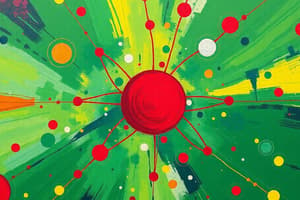Podcast
Questions and Answers
Neutrons have a positive charge and the same mass as protons.
Neutrons have a positive charge and the same mass as protons.
False (B)
In Bohr's atomic model, electrons orbit the nucleus in a random manner.
In Bohr's atomic model, electrons orbit the nucleus in a random manner.
False (B)
Isotopes are atoms with the same number of neutrons but different numbers of protons.
Isotopes are atoms with the same number of neutrons but different numbers of protons.
False (B)
Protons have a mass approximately 1836 times greater than electrons.
Protons have a mass approximately 1836 times greater than electrons.
In the quantum mechanical model, electrons are described as probability waves in energy levels.
In the quantum mechanical model, electrons are described as probability waves in energy levels.
Hydrogen-3 is an isotope of hydrogen with two protons and one neutron.
Hydrogen-3 is an isotope of hydrogen with two protons and one neutron.
Isotopes are designated using the atomic number followed by the mass number.
Isotopes are designated using the atomic number followed by the mass number.
An atom with an equal number of protons and electrons is considered neutral.
An atom with an equal number of protons and electrons is considered neutral.
The atomic number of an element is determined by the number of neutrons in the nucleus.
The atomic number of an element is determined by the number of neutrons in the nucleus.
Atomic structure is not a critical field in modern science.
Atomic structure is not a critical field in modern science.
By examining isotopes, scientists can uncover the underlying principles governing chemical interactions and physical properties.
By examining isotopes, scientists can uncover the underlying principles governing chemical interactions and physical properties.
Study Notes
Atomic Structure: Exploring Subatomic Particles, Atomic Models, and Isotopes
Atoms, the building blocks of all matter, consist of three fundamental subatomic particles: protons, neutrons, and electrons. Each of these components plays a crucial role in shaping an atom's properties and behavior.
Subatomic Particles
Protons: Positively charged particles found in the nucleus, they have a mass approximately 1836 times greater than an electron's.
Neutrons: Neutral particles found in the nucleus, they have the same mass as protons but no charge.
Electrons: Negatively charged particles that orbit the nucleus in distinct energy levels called shells.
Atomic Models
Over time, several atomic models have been proposed to explain the structure and behavior of atoms. Some key models include:
Rutherford's model (1911): A planetary model in which electrons orbit a small, dense nucleus.
Bohr's model (1913): Postulated specific energy levels for electrons, predicting their behavior during transitions.
Quantum mechanical model (1920s): A modern, more accurate model that describes electrons as probability waves in energy levels, allowing for a statistical explanation of atomic behavior and properties.
Isotopes
Atoms with the same atomic number (number of protons) but different mass numbers (number of protons plus neutrons) are called isotopes. For example, hydrogen has three isotopes: hydrogen-1 (protium), hydrogen-2 (deuterium), and hydrogen-3 (tritium). Isotopes are designated using the atomic number followed by the mass number (e.g., ({}{1})H({}{1}) for protium, ({}{1})H({}{2}) for deuterium, and ({}{1})H({}{3}) for tritium).
Neutral Atoms and the Periodic Table
A neutral atom has an equal number of protons and electrons, ensuring that the positive and negative charges balance each other. The number of protons in the nucleus determines the element's atomic number and its position on the periodic table.
Conclusion
Atomic structure is a critical field in modern science, providing a detailed understanding of the world around us. By examining subatomic particles, atomic models, and isotopes, scientists can uncover the underlying principles that govern chemical interactions and physical properties. This knowledge is essential for advancing our understanding of the universe and developing new technologies.
Studying That Suits You
Use AI to generate personalized quizzes and flashcards to suit your learning preferences.
Description
Test your knowledge on the fundamental components of atoms including protons, neutrons, and electrons, explore historical atomic models like Rutherford's and Bohr's, and learn about isotopes and their significance in the periodic table.




